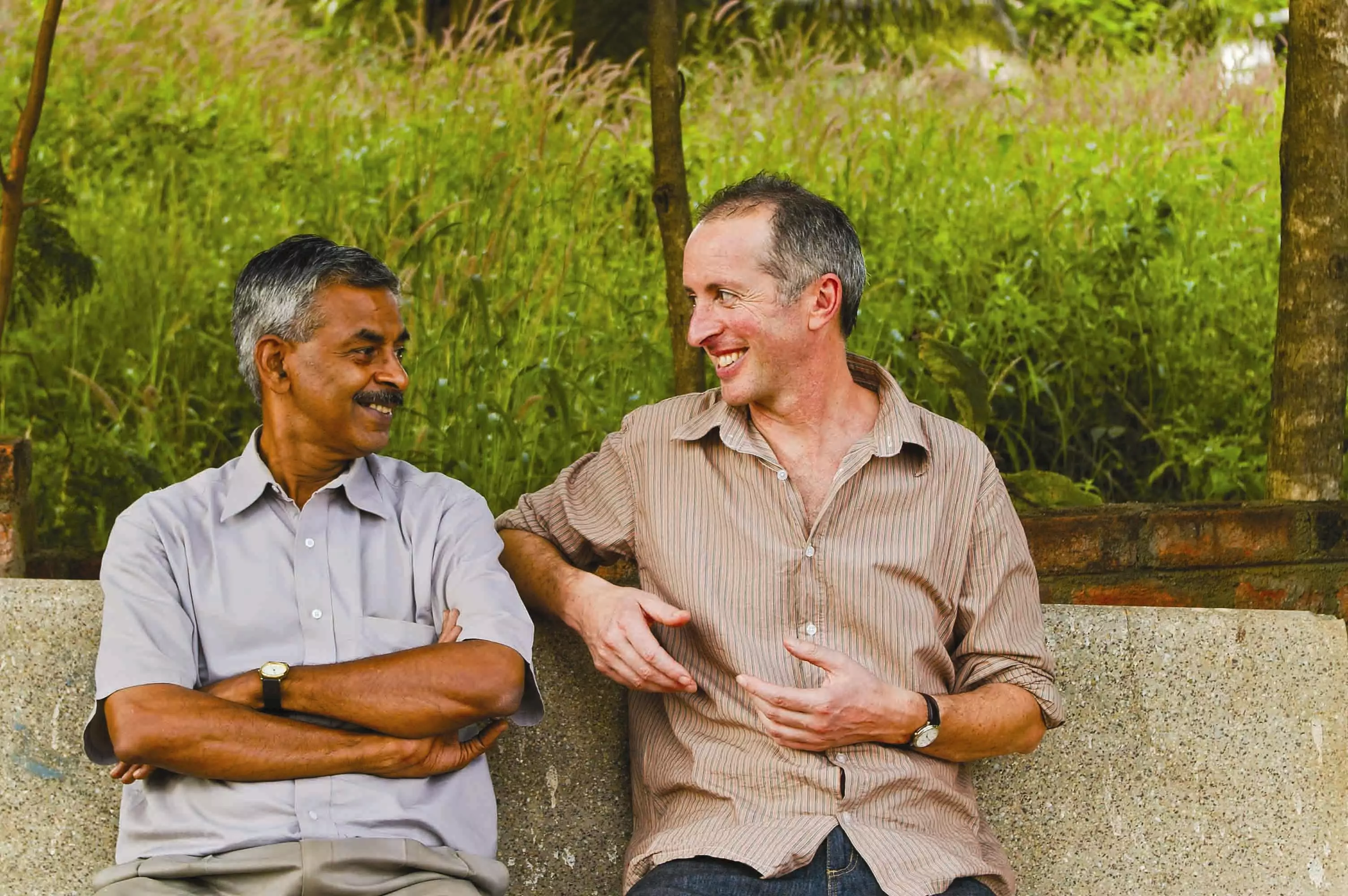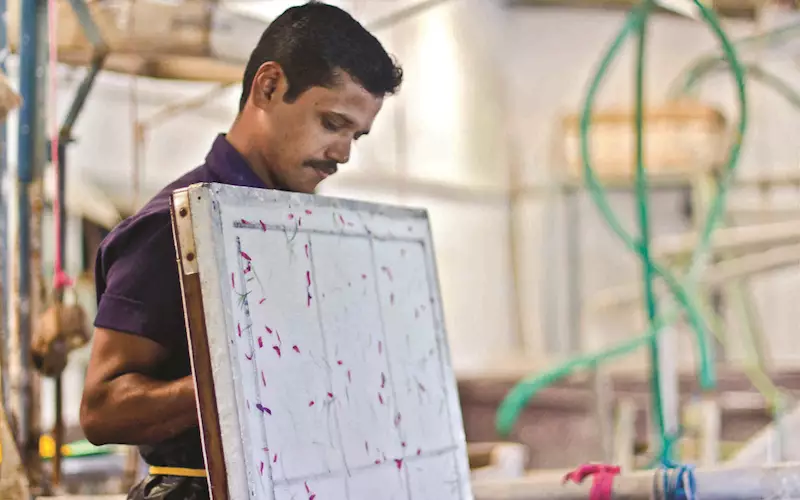The name, Khadi, automatically evokes Gandhian ideology. This, however, is not the only interesting aspect of Khadi Papers, a range of handmade papers manufactured in Hubli, Karnataka, by an Indian national and sold worldwide by a British national, in the art world, in a partnership, which is more friendship than business. Dibyajyoti Sarma talks to Nigel Macfarlane of Khadi Papers
It all started with art, really. Barbara Macfarlane is a professional artist who lives and works in the UK. Most of her output is on handmade rag paper sourced from India. Her medium is pigment on paper. Working often on a large scale, she makes the texture of her handmade rag papers play an important part in each image. Contrasted against the intensity of oil paint, the lambent brightness of water colour, the calligraphy of charcoal lines or scratched marks, these artfully deployed expanses of naked paper provide both a unity and luminosity to Macfarlane’s work.
The husband and wife duo, Nigel and Barbara Macfarlane, would purchase the handmade papers for the artwork from the Handmade Paper Institute in Pune, way back in the 1980s. Established in 1940, based on Gandhian principles, and run under the aegis of the Khadi and Village Industries Commission, the institution works towards training and research in handmade papers and also towards promoting the cause.
Not only for their own use, the Macfarlanes soon started buying art papers from the Pune institute and started selling them to artists at the various London art schools and artists in the UK. This is when they met Vasudevan, the manager of the institute, in 1984. A friendship was struck, and this is where it all started.
Today, Khadi Papers, run by Nigel Macfarlane, is an importing and distribution company based in the UK. On the other hand, Khadi Papers India is a proprietary company based in India. Together, they promote Indian handmade paper on the world market.
“It started really through a friendship with Vasudevan,” says Nigel Macfarlane. “In 1994, Vasudevan started Khadi Papers India with financial support from our side and with the guarantee that we would purchase the product. The amazing thing is that this has all been done and achieved on the basis of trust. We have a close relationship with our ‘Indian family’.”
The process is simple. The papers are manufactured by Khadi Papers India in a mill located outside Hubli in Karnataka, and then are shipped to a warehouse in London, from where Khadi Papers distribute the products all around the world. Though the company sells the papers online, it also has established art supply retailers worldwide. The production is around 30 tonnes per annum.
The village of Tarihal near Hubli, where the mill is located, is a cotton-growing area, which is also a raw material for the papers. Here, Vasudevan works with his cousin Subu, who had previously worked at the paper mill of TARA (Technology and Action for Rural Advancement) in New Delhi and his cousin Srikumar, who also trained at Pune. “Our mill is outside Hubli, in an industrial area with access to 3-phase power, but close to real rural India. Currently, we employ 60+ workers from the local villages, with 60:40 male-female ratio. We are also proud to employ a number of workers with physical disabilities,” says Macfarlane.
In India, there is a traditional method of making handmade papers. But in today’s time, there is a need for modern technology. “We are innovators,” says Macfarlane. “We are constantly adapting traditional methods to meet contemporary conditions. For example, we have redesigned the lifting vats to reduce the physical demands on the workers, making it more comfortable for them to make paper.”
Khadi Paper India produces Indian cotton rag papers. These are made from 100% cotton rag, which have longer fibres than linters, which are the shorter fluffy fibres of the cotton seed generally used in paper making. Macfarlane says it is the fibre length of this raw material that gives Khadi rag papers their strength and durability. “The cotton rag we use comes from T-shirt cuttings, a reliable source of pure woven cotton,” he adds.
The company also manufactures Himalayan Papers in Kathmandu valley and Gorkha district of Nepal and in Trashi Yangste, Eastern Bhutan. “In Nepal and Bhutan, we have worked with the same papermakers for over twenty years. Milan Bhattarai’s company, GET Paper, in Nepal was very small when we started working with him in 1983 and now employs 120 people, of whom 60% are women,” says Macfarlane.
Himalayan papers are made from the bark fibre of lokta (daphne bholua) or mitsumata (edgewothia papyrefera). These are native plants which grow at high altitude in the Himalayan forests. This fibre is a renewable resource. Plants are cropped above ground level and re-grow from the radial root. They can be re-harvested after three years.
About the process of making papers at Khadi Papers India, Macfarlane says: “Papermaking is dependent on water, and our supply comes from our own borewell and from rainwater capture. We recognise the value of water and we ensure none of it is wasted. First, the ‘virgin’ water is used for white papers, then it is recycled for light, then dark colours and for crop fibre papers.”
Art remains to be the focus. The specialised market for the company is paper as an artists’ material for watercolour and other art media. “We are also into specialist environment-friendly packaging, including printed papers. We supply, for example, packaging papers for Lush Cosmetics sold globally,” Macfarlane adds.
Environment-friendly is an easy tag to attach to a product. However, it doesn’t always mean a lot. “I have seen a number of small scale industries that are nevertheless polluting the watercourses,” Macfarlane argues. “I cannot speak for other manufacturers, but we do make sincere efforts in this regards. For example, the run-off water after the papermaking process in our mill has received accreditation from the Karnataka State Pollution Control Board as fit for irrigation. We use this water to grow bananas, mangoes and organic vegetables in our compound.”

|
How paper is made?
Indian cotton rag papers
Manufactured at: Hubli, Karnataka
The rag papers are made from 100% cotton rag, which comes from T-shirt cuttings. Rags are pulped in a Hollander beater. Neutral pH internal size (glue) is added at this stage. Coloured papers are dyed in the beater using direct dyes from Ciba and Clariant. Increasingly, the mill is sourcing coloured rags, enabling them to reduce or entirely avoid the use of dye.
Handmade papers are made sheet by sheet. Cotton fibres in suspension in water are poured onto the paper mould. The mould is a wooden frame with a wire mesh draining surface. A second frame, the deckle, rests on top. The sheet is formed on the mould in a vat of water. The process involves a very small amount of fibre and a lot of water. The fibre is retained on the surface of the mould while the water drains through the mesh. The characteristic deckle edges of the sheet of paper come from the slippage of pulp between the deckle and mould. The mould is lifted from the vat and the sheet is laid or couched onto a woollen felt. Another felt is placed on top and the process is repeated. When a pile of sheets interleaved with felts has been made they are pressed in a hydraulic press to remove excess water. Rough surfaced papers retain the impression of the woollen felt. Smooth papers are cold pressed between zinc sheets. Papers are loft dried. After drying, sheets are tub sized (surface sized) with gelatine which produces a hard, water resistant surface.
|
Himalayan Papers
Manufactured at: Kathmandu valley and Gorkha district, Nepal; Trashi Yangste, Eastern Bhutan
Himalayan papers are made from the bark fibre of lokta. The stripped bark is boiled in an alkali solution, which breaks down the lignin in the cell walls allowing the fibres to separate. Traditionally a lye of ashes was used for this purpose, formed by dripping water through a basket of hardwood ashes. Now, while traditional Nepalese papers use caustic soda, Khadi Papers use soda ash, which does not harm the fibres. The fibre is beaten with a wooden hammer on a flat stone. Nepalese mountain papers and Bhutanese resho paper are made by churning the pulp in water and pouring onto a mould which is a wooden frame with a cotton cloth stretched over its surface. The mould is positioned in a shallow pool and the sheet is formed in water by spreading the pulp over the surface of the mould. The paper is dried on the frame which is propped up and angled towards the sun. This is the most primitive way of making paper, and has remained unchanged for over 1,000 years.
|















 See All
See All